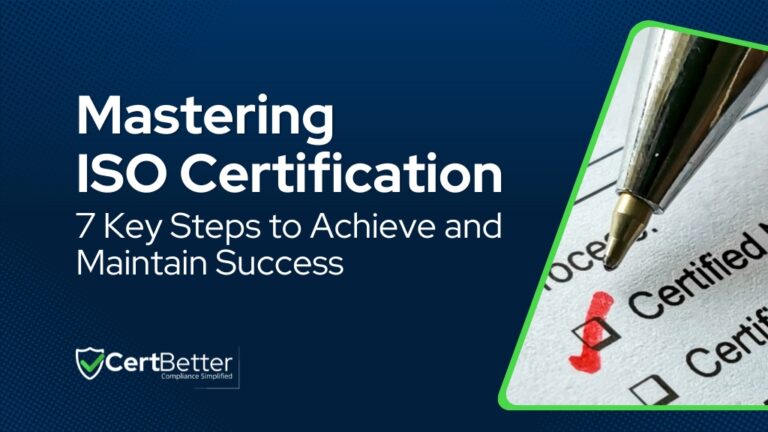7 Steps To Achieve ISO Certification With Examples

At some stage during business meetings, you might come across the acronym ISO certification or ISO standard. If you’ve ever wondered about the importance of ISO compliance and how to achieve it for your business growth, you’re on the right page. In this guide, I’ll explain everything you need to understand about ISO and why its certification carries so much importance in today’s (or future’s) business environment.
Is ISO Certification Important?
Yes. The ISO certification is very important if you’re looking to expand your business. The ISO Certification can help you with pre-qualification for contracts, improve your brand, customer service, operational assurance and demonstrate your commitment to the standards.
About ISO — A Brief Background
ISO — the International Organization for Standardization — lies at the heart of the global standards-setting landscape.
ISO is an independent and non-governmental international organization with a fundamental mission: the development of standards.
All ISO standards serve as the backbone, ensuring that products, services and business processes attain the pinnacle of quality, safety and efficiency (well, such expectations vary depending on which standard you’re thinking about!).
These standards span a vast spectrum of industries, encompassing everything from technology and safety protocols to management practices and societal welfare.
Established in 1947, ISO has undertaken the monumental task of crafting more than 23,000 international standards.
ISO’s commitment to excellence and its global reach make it an indispensable player in today’s interconnected world, where consistency, reliability and innovation are the cornerstones of success.
Why is ISO Certification so Important?
ISO standards are not just a bunch of standard rules that were put together by random people; they were carefully made by industry experts from all over the world with the intention of benefiting businesses.
When your business complies with an ISO standard, it signifies the following:
Global Uniformity — Probably the biggest reason for adapting an ISO standard is because it plays a pivotal role in maintaining a harmonized global management of systems and processes.
This uniformity fosters international trade, simplifies supply chain management and improves consumer confidence. Imagine purchasing a product, no matter where it’s manufactured, with the confidence that it meets the same high-quality standards.
Reputation Boost — Holding an ISO certification is like waving a flag of commitment to quality and consistency. It sends a clear message to your stakeholders (suppliers, staff, customers, regulators, etc) that your business is dedicated to delivering a standard level of products or services.
Reducing Conflicts — ISO places a paramount emphasis on quality of operations. By establishing rigorous criteria into your business activities, ISO standards safeguard end users from potential harm or conflict associated with your products and services.
It’s a win-win for your business because it allows you to identify and address issues before delivering your products or services, ensuring customer satisfaction and trust while minimizing conflicts.
When you encounter a product or service adhering to ISO standards, you feel a kind of trust that it has undergone independent and impartial examination.
Improvement and Innovation — Like I mentioned before, ISO standards aren’t just about rules; they also offer great guidelines that highlight areas for business improvement and foster innovation among industries.
Reduced Risks — ISO’s focus on consistent quality checks and guidelines reduces the risks associated with quality failures or oversights. By adhering to ISO standards, businesses can mitigate the potential financial and reputational consequences of quality-related issues.
Operational Excellence — ISO standards serve as a roadmap for operational improvement. They help streamline processes, minimize errors and enhance overall efficiency.
ISO standards serve as benchmarks for companies aiming for continuous improvement (assuming you understand their importance and requirements!).
Now that you recognise the importance of ISO standards in relation to your business growth, the next question is how to obtain one. So, how does it work? Let’s dive into the process.
07 Steps To Achieve ISO Certification
The journey towards achieving ISO certification involves several key steps. I’ll tread carefully here because this section holds significant importance and applies to many popular standards, including ISO 9001, 14001, 45001, and 27001. Let’s have a look at the key steps quickly:
Gap Analysis
This involves assessing current processes against ISO standards to identify gaps. It’s like checking if your puzzle pieces fit together perfectly or if there are missing pieces that need to be found and placed correctly.
IMPORTANT — Make sure you understand the basic ISO terms and their meanings to avoid any confusion.
Documentation
After identifying the gaps from your gap analysis, it’s time to put things on paper. You’ll start by making clear records like procedures, charts, forms and templates. All of that becomes your management system.
Management system documentation step shows that you’re serious about following the ISO standards but keeping them in line with your business activities.
Training
Staff training is very important to ensure all team members understand who’s who and what’s what in your business as per the ISO compliant documentation in place.
Team meetings, toolbox talks, posters, induction and workshops are the best ways to train and make your staff members (and contractors too!) aware so when the auditor interviews someone at your business, they should be able to demonstrate they understand their responsibilities and the basics of your management system. feel like they are on the same page!
Implementation
Once all is set up and everyone is onboard, the next step is to implement “do what you say“. This means actually doing what you’ve laid out in your checklist and processes. It’s like following a recipe in the kitchen — you need to execute the steps you’ve planned.
Take your time with this phase because it will provide valuable insights into what’s working well and what might need adjustments along the way.
Internal Audit
This is not an inspection for your project or an operational check! Internal auditing is a self-assessment process of validating a business management system’s commitment to “Do you actually do what you say?“
The internal audit ensures that everything is on the right track and compliant with ISO standards (and with your business policies and procedures). It’s an opportunity to identify and rectify any issues before the external auditor arrives.
Management Review
Consider this your periodic checkup meeting attended by the top management to review all aspects of your management system that are required to achieve and maintain ISO certification.
Discussions mostly involve about how your management system is performing, what the future holds and making any important decisions to keep improving your management system.
Important: Management review meetings should NOT be treated as separate isolated meetings to just discuss your ISO certification. Take it as a business meeting that also includes review of your management system.
For example, if you’re certifying your business for the ISO 9001 Quality Management System then your management meeting should cover basic agenda items as required by clause 9.3 of the above standard.
Certification Audit
Finally! It’s time to book an audit with an accredited certification body. An external auditor comes down to review your system, interview staff members and verify related processes. If all goes well, the auditor recommends your business for the requested ISO certification.
Recommended read: Top 10 Criteria for Selecting Best ISO Certification Body (With Checklist)
Surveillance Audits
Technically, not part of initial certification but once you’ve earned your ISO, you’ll undergo regular check-ups, known as surveillance (or recertification) audits, to make sure you’re still following the ISO standard(s) to maintain the certification requirements.
Common Challenges of ISO Certification
While the benefits of obtaining and maintaining ISO certification are clear, it comes with its own set of challenges. In short, it’s not a one-time check-box exercise. Let’s take a look at some of the common challenges:
Understanding ISO Concepts
While auditing some companies, I found that they treat ISO certification like a checkbox exercise, which eventually damages their business integrity. Consider this a journey of continuous improvement and soak in its essence.
I also come across some clients who confuse the difference between certification vs accreditation. I recommend you have a look at that before you start looking to achieve your ISO certification.
Your intention should be to embed the ISO requirements into your exisitng business processes (like sales, marketing, operations, etc.) so it all makes sense and you’re business is actually getting the benefits through improvement management of those processes.
Once you understand the ISO concepts, it should not be too difficult to implement the requirements and incorporate them into your business processes.
One thing I always tell my clients is that “every business has an ISO system in place naturally.” It’s just that they need to understand and realise it before puttting it into practice.
Ongoing Audits
Like I mentioned above, ISO certification is not a one-time exercise but an ongoing commitment. Certified businesses undergo regular surveillance or recertification audits to ensure they continue to meet ISO standards.
These periodic external audits require adequate time, resources and sustained adherence to maintain your certification status.
Initial Investment
I should have listed this first, but in my opinion, the advantages outweigh the costs. Obtaining and maintaining ISO certification involves both financial and time investments.
Costs usually include certification fees, additional charges, paid training, consultancy fees and the paid resources required for achieving and maintaining ISO compliance.
The ISO Certification Journey
While achieving ISO certification might seem like just another routine business task but rest assured its advantages are extensive and significant. In a world where credibility can distinguish businesses from the competition, ISO certification stands as proof of your company’s dedication to quality, consistency and continual improvements.
As long as your management system is aligned with your business practices and keeps evolving to support your business goals, you’re well-prepared for ISO certification!
- Last updated: May 22, 2024
- CertBetter
Our community of compliance professionals and ISO experts is ready to provide you with insightful answers and practical solutions. Join the discussion now!
- Recommended Reads
- 36 reads
-
Frequently Asked Questions
Understanding ISO Terminology: Guide to Important Terms and Concepts
No posts found
ResetConnect with ISO Certification Consultants
CertBetter makes it easy to find ISO certification consultants and compliance professionals from around the globe.

